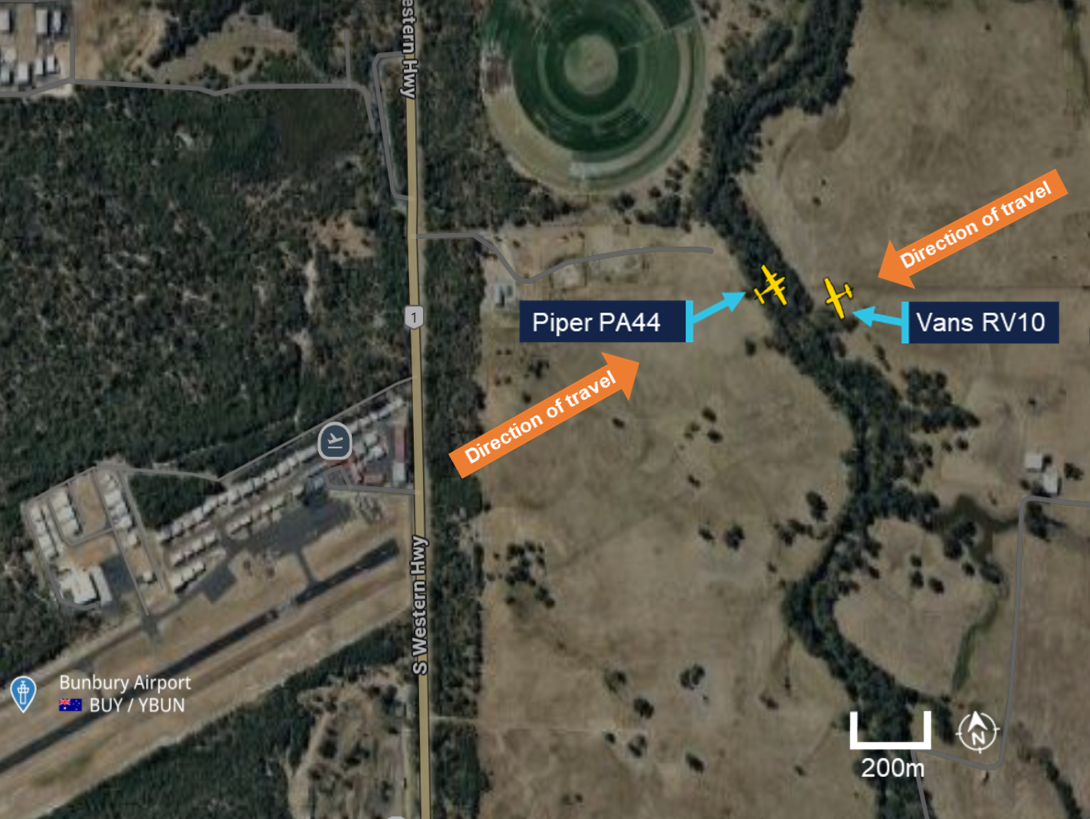What happened
On 25 March 2025, the pilot of a Piper PA-44 was conducting solo circuit training operations on runway 07 at Bunbury Airport, Western Australia, operating under visual flight rules (VFR). While established on a left base circuit leg for runway 07, the pilot heard an inbound radio call on the common traffic advisory frequency (CTAF) from a Van's RV-10, 10 NM to the north-east tracking for the field. As the PA‑44 was already established in the circuit, the pilot reported that they believed they had priority.
The pilot of the RV-10 was conducting an instrument familiarisation flight, with a flight plan lodged under instrument flight rules (IFR). Tracking from the north‑east to Bunbury, the RV-10 was conducting a straight in required navigation performance (RNP) instrument approach for runway 25. Shortly after making the 10 NM call, the pilot of the RV-10 began to align with runway 25 and configure for the approach, descending not below 2,800 ft.
At the time of the RV-10’s arrival into the aerodrome, the PA‑44 was already established on runway 07 circuit operations. Neither pilot reported hearing or arranging arrival or departure sequencing at the time.
The pilot of the PA‑44 was unaware of any imminent conflict and initiated a touch‑and‑go on runway 07. The RV-10 was approximately 5 NM from the runway 25 threshold on a reciprocal heading to the departing PA‑44.
At approximately 3 NM from the threshold of runway 25, the PA‑44 (upwind for runway 07) made a radio call asking if the RV-10 was aware of a potential conflict. The RV-10 pilot advised that they had the PA‑44 in sight and intentionally descended below the reciprocal track in an attempt to increase separation. The pilot of the PA‑44 commenced an early left turn onto crosswind to avoid any further conflict. Separation between the 2 aircraft was reduced to 50 m horizontally at the same level.
Figure 1: Near collision between 2 aircraft on reciprocal headings

Source: Flight Radar24, annotated by the ATSB
Safety message
This occurrence highlights the requirement for pilots to always maintain a strong sense of situational awareness especially when operating at a non‑controlled aerodrome. When conducting an instrument approach in uncontrolled airspace, it is best practice to sequence your aircraft’s arrival with other established traffic (both VFR and IFR) operating in the area.
Alerted see and avoid communication is encouraged, particularly between VFR and IFR operated flights, as instrument approach procedures may interfere with VFR operations in visual conditions.

The ATSB SafetyWatch highlights the broad safety concerns that come out of our investigation findings and from the occurrence data reported to us by industry. One of the safety concerns is reducing the collision risk around non-towered airports.
About this report
Decisions regarding whether to conduct an investigation, and the scope of an investigation, are based on many factors, including the level of safety benefit likely to be obtained from an investigation. For this occurrence, no investigation has been conducted and the ATSB did not verify the accuracy of the information. A brief description has been written using information supplied in the notification and any follow-up information in order to produce a short summary report, and allow for greater industry awareness of potential safety issues and possible safety actions.


